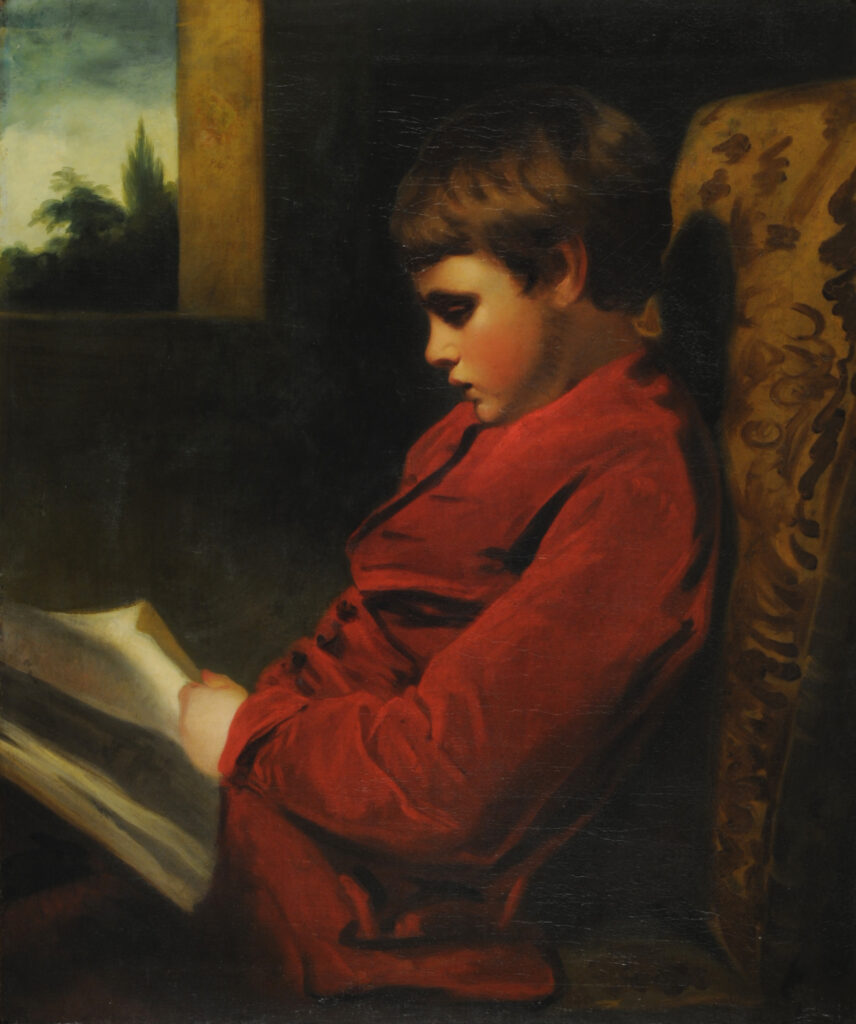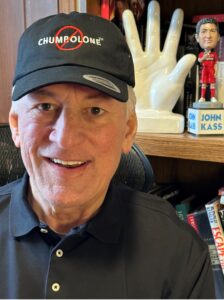By John Kass
July 30, 2025
What was the name of that book?
You know the one. You can see yourself as a child stretching for it on a high shelf at the library.
You began reading in that soft afternoon sunlight as you sat at one of those polished wooden tables, the librarian keeping order, peering through the glasses on her nose.
Or perhaps you didn’t read it at a library. It could have been in your bedroom where you first opened that book.
Or maybe it was on a blanket in the park with your brothers and mom. There we were at Sherman Park lagoon, at 55th and Racine in our neighborhood on that heavy woolen green blanket Yia-Yia’ had woven on her hand loom back in the village.
The lagoon was a couple of miles from the Union Stockyards, near the Sherman Park Library. The air around us wafted the scent of tens of thousands of livestock, when I was a boy and Chicago was still the butcher for America.
“What’s widdershins?” asked my brother Peter as our mom read to us from Childe Roland and the Goblin King, one of the books in the great My Book House collection we had as children.
Widdershins was an olde English word, squeezed out of Middle Low German and Middle High German, perhaps through Wales or Scotland, meaning to go counterclockwise around the tower. At least that’s where all the trouble started with the Goblin King. It started running widdershins around the tower. And there was much lopping of heads.
There on the blanket, or there in the library I’m reaching to find that book. Not the book title exactly, but the feeling of a book as your friend. One you didn’t want to leave as your parents called you for dinner in the late summer, as the afternoon got darker until you could hardly see the words on the page.
A book you’d reach out to for comfort. It might be the Bible, the New Testament, and the gospel. Or, what of the story of Odysseus horrified that his men were turned into pigs by the beautiful witch Circe.
You might know it.
Don’t forget those “We Were There” historical books such as “We Were There at Gettysburg” or “We Were There at the Boston Tea Party,” or “We Were There at the Battle for Bataan” or the Crusades, usually involving boys back in those days of yore, before boys became a threat, before being a boy meant they might actually mature into toxic male adults, the kind of creature that ruined everything and should be shunned if not gentled. Or worse. Unless there was a war to fight.
One that I suppose I’ll never find is a book I found at the Gage Park Library down the street from our family supermarket, Gage Park Grocerland. The story involved a group of children, the eldest, a bookish girl named Meg who wore glasses and bulky sweaters. All the smartest girls in books were named Meg, weren’t they?
The kids lived on a farm that was surrounded by water, including a lake and a spring fed pond, and two little creeks. It was technically an islanx. I spent summer morning at the store, puttering around the butcher shop in what I would later call Greek Day Care, later hiding from the summer heat in the meat cooler, eating sauerkraut straight from the barrel, later heading out into the alley where Ernie the photographer kept a vicious pink-nosed fat spaniel named Scaramouche. And then to the library where I found that book on the kids of the farm. Their island was a certified paradise. There were dogs on the farm and they had an understanding father. They all were well mannered, not the stuffy manners of a prissy Little Lord Fauntleroy, but high-spirited good manners and they were literate or hoped to be.
And their sister Meg. I wondered about her.
All that was a universe from today’s world, and the mid-town frenzy of New York, where a lunatic fiend slaughtered innocents with a long gun just the other day, a madman with a concealed carry permit blaming his killing spree on football concussions; or of Cincinnati and that race riot with that woman beaten unconscious by a man, hit by a sucker-punch and all the other barbarians hooting it up, gleefully ecstatic that white people were being smashed to the ground. The media–that praises itself for “speaking truth to power”–did what it does best now. They ignored the story, pretended it didn’t happen.
The human animal is an animal. I know this to be true. I just wanted to step away from it for today, just for the moment, away from those barking political dogs feeding fears that young people must turn to Mamdani the Magician for communist magic to protect their jobs from AI reality. He’s not that powerful. His kind of sentimental mindless magic can only lead to horrors such as the Killing Fields.
But that is not a proper subject for children. And neither was that left-wing segment on public television (Wilmette Talking to Winnetka) bemoaning the loss of hospitals providing “gender affirming care” to children. That is not care. It is castration, something only a Dr. Mengele would support.
And that is not a subject appropriate for kids.
This subject though is appropriate.
Even that drunken peg-legged pirate with the filthy parrot.
Years ago, when I was writing a daily column for “the paper,” I asked readers for recommendations for books for kids. I expected a few letters and e-mail messages. What I didn’t expect were the overwhelming numbers of responses from Illinois and across the country, hundreds and hundreds and hundreds of them.
They were the people who loved books. The letters came from girls and boys and teachers and parents and uncles and aunts and grandparents and many librarians. They know what it is like to lose yourself in a good book under a tree in the afternoon, or in bed with a flashlight, after your parents thought you’d gone to sleep.
Some came from computer experts who don’t want their kids anywhere near a computer screen. And some were from people who don’t have children of their own, but who give books to kids as presents, only after reading them first before deciding what is appropriate for the child. It sounds like good common sense to me.
And there was this from John Downey, a dad from Geneva who sums it up perfectly:
“The most important book is the book a parent reads to and with their child.”
Many years ago, the youngest correspondent on the topic of books was 9-year-old Stanton Simms. He recommended “The Twenty-One Balloons” and other books by William Dubois, the Winnie-the-Pooh stories by A.A. Milne “and any book that doesn’t have pictures.”
Young Master Stanton Simms was referring to the original Pooh books, not the cheap bastardizations of great stories by Disney. Stanton understood the distinction, so I expected he would do well in the world and steer his own children clear of everything infected by the Disney woke world.

Some suggested “Treasure Island,” the great pirate story by Robert Louis Stevenson. Stevenson also wrote the novel about friendship, “Kidnapped,” and “Captains Courageous,” the tale of a young boy who learns how to become a man.
Also suggested were “The Just So” stories by Rudyard Kipling and his “Jungle Books.” I’d also throw in “Kim.”
Fred and almost everyone else recommended the Narnia books by C.S. Lewis, the great Christian moralist whose books for children are necessary. Also, “The Lord of the Rings” by J.R.R. Tolkien and his other related books, and “Children’s Stories” by the brilliant and mischievous Isaac Bashevis Singer.
Here are some other recommendations. “Have Space Suit Will Travel” was one of my favorites by Robert A. Heinlein. As were the King Arthur books by T.E. White, including “The Once and Future King.”
Also “Rascal” and other nature books by Sterling North; “My Side of the Mountain” by Jean Craighead George, about a boy who lives alone in the wilderness; “Rifles for Waitie,” the Civil War story by Harold Keith; “Drums Along the Mohawk” by Walter Edmonds; the Revolutionary War tale “Johnny Tremain” by Esther Forbes; and “Call it Courage” by Armstrong Sperry about a young boy marooned on an island of cannibals.
And don’t forget “Robinson Crusoe” by Daniel Defoe and “Gulliver’s Travels” by Jonathan Swift. Children also should read “The Three Musketeers” and “The Count of Monte Cristo” by Alexandre Dumas; the stories of Jules Verne; and “A Wrinkle in Time” by Madeleine L’Engle, and Charlott’s Web by E. B. White. No children’s library would be complete without them.
Other good writers of children’s books include Robert McCloskey; Donald J. Sobol, who wrote the Encyclopedia Brown books; and Roald Dahl, who wrote “James and the Giant Peach” and “Big Red” by Jim Kjelgaard, Black Beauty by Anna Sewell and other classics.
There are two I’d recommend. The first is the Odyssey of Homer, the greatest adventure story ever told and my favorite book of all time. A wonderful children’s version, “Odysseus the Wanderer” by the scholar Aubrey De Selincourt is out of print, but there are two copies available at the Chicago Public Library.
Another author I’d recommend to children 12 and older is the great Polish novelist Henryk Sienkiewicz, who wrote what is commonly called The Trilogy. It’s like reading The Three Musketeers, only it is written by a Nobel Prize winner, which was awarded to Sienkiewicz for “Quo Vadis.”
The Trilogy is a story known by all Polish people and has been retranslated and published by the Hippocrene Book company of New York. It is a story of friendship and honor and love and patriotism and revenge, during a terrible, long forgotten civil war.
The first volume “With Fire and Sword” takes place during the Cossack uprising of the 1600s, when a young Polish noble rescues a powerful Cossack hetman from lariat-wielding Tartar slavers during a raid on a cold moonless night on the wild Steppe.
Trust me on this one.
I once would have said you should definitely trust your librarians too, but that was before the time—at least in Illinois and other deep blue states—where librarians began supporting corrosive nonsense like “Drag Queen Story Hour.”
Not on my taxpayer’s dime, thank you very much.
You really can’t trust anyone with the mind of your child. You must be involved. Read what they read. Read to them. Have them read to you also.
You know they’re sponges, modelling everything you do.
There will be time enough later to introduce other approaches to rigorous, serious reading on politics, economics, history, but right now summer is about to turn, the tomatoes in the backyard garden will ripen and demand bacon and the days will get shorter. And kids will go back to school.
Time to sit on the porch in the shade with a tall glass of lemonade and just read.
There was a book.
What was the name of that book, again?
Let me know right here, in the comments section below. We’d love to read your great books list.
-30-
 About the author: John Kass spent decades as a political writer and news columnist in Chicago working at a major metropolitan newspaper. He is co-host of The Chicago Way podcast. And he just loves his “No Chumbolone” hat, because johnkassnews.com is a “No Chumbolone” Zone where you can always get a cup of common sense.
About the author: John Kass spent decades as a political writer and news columnist in Chicago working at a major metropolitan newspaper. He is co-host of The Chicago Way podcast. And he just loves his “No Chumbolone” hat, because johnkassnews.com is a “No Chumbolone” Zone where you can always get a cup of common sense.
Merchandise Now Available: If you’re looking for a gift for that hard-to-buy for special someone who has everything, just click on the link to the johnkassnews.com store.
Where else would you find a No Chumbolone cap or a Chicago Way
cap or a Chicago Way coffee cup?
coffee cup?
Because I know this about you: You’re not a Chumbolone.
The post There Was a Book appeared first on John Kass.
Click this link for the original source of this article.
Author: johnkass
This content is courtesy of, and owned and copyrighted by, https://johnkassnews.com and its author. This content is made available by use of the public RSS feed offered by the host site and is used for educational purposes only. If you are the author or represent the host site and would like this content removed now and in the future, please contact USSANews.com using the email address in the Contact page found in the website menu.





